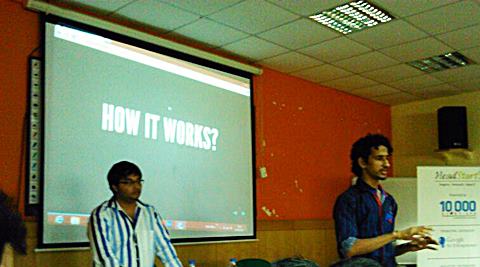Jarvis is an intelligent OS inspired by Iron Man
Source: Nandagopal Rajan

jarvis2 Chirag Dewan and Himanshu Vaishnav explaining the concept
At the core of Jarvis is artificial intelligence, which the duo think can be included in the system as a component.
Personal technology has always been inspired by fiction. For instance, the world got its first glimpse of the mobile phone in the popular TV series Star Trek. Now, taking a cue from Iron Man, two young Indian technologists want to play Tony Stark and ask their computer to do stuff for them. To make things easy, their intelligent assistant is also called Jarvis after Stark’s virtual butler.
Delhi-based Chirag Dewan and Jaipur’s Himanshu Vaishnav, both computer science students in their early twenties, think their idea of artificial intelligence can change computing for ever. While start-ups the world over are working on solutions that make input methods for computing more natural, Jarvis Corp is working on an entire operating system that is fully automated and learns as it goes. Of course, it will interact with the user with the help of voice and gestures along with traditional input methods.
“From the origin of operating systems, everyone has been following the same thing. All of them have the same internal structure with a similar skin and flesh. With each new version of an operating system we are just seeing a new set of features being added to this legacy,” says Dewan, on a Skype call from the US. He says Jarvis is a totally redesigned OS. “We are not changing the paradigm, but we will change user experience for sure.”
At the core of Jarvis is artificial intelligence, which the duo think can be included in the system as a component. “So, the next time it performs even better. With the inclusion of unconventional inputs as the standard, you will communicate with the system as if it is an individual,” adds Vaishnav.
Now you know that it is called Jarvis. But if you thought this would be an ideal solution for a mobile operating system, where users are already using voice and gestures for input, you are mistaken. Jarvis Corp, strangely does not want to tackle what for everyone is the fastest growing computing segment. They want to start with the traditional desktops and maybe other connected devices and home automation. But not smartphones. That would be too easy.
“We are a start-up and would like to see how it works before scaling up,” adds Dewan, who is the CFO of the company which now has 10 people working on the project in multiple countries. The two, who met on the Internet due to their shared passion for artificial intelligence, scouted for like-minded talent by launching a website seeking applications. They got 3,000 bios, of which they have roped in eight so far.
| }
|